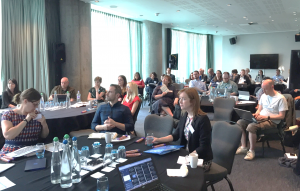This blog post was written by Steve Stapleton, Associate Director – Learning Technology, University of Nottingham.
The University of Nottingham’s 6C model of Open Educational Resource Publication (OER). The 6C model (Figure 1) was first used at Nottingham in 2009 as part of the Jisc funded BERLiN project. The project manager for that project was Andy Beggan, and it was Andy who defined the 6C model to formalise the process that Nottingham used to create and publish Open Educational Resources (OER). The model remains in use at Nottingham as part of the OER publication model, and was adapted for use as part of the Jisc Collections funded ROMe project to publish Nottingham’s e-textbooks. The model would be easily adaptable to other institutions and other online content creation contexts, and has served Nottingham well over the years.

Figure 1 – The 6C model and how it was used to facilitate the creation and publication of the e-textbooks
Contribution
This phase of the model involves setting up processes to receive content into the team that will carry out the clearance and construction phases. For the institutions as e-textbook publisher project, the Department of Philosophy and Nottingham University Business School provided their manuscript content and supporting images to the Learning Technology Team. The Applied Ethics book was contributed as a word file which was text only. The Corporate Social Responsibility in Practice (CSRP) book was contributed as multiple word files, with supporting media and instructions for how to build the book.
Clearance
This phase of the model looks at rights clearance, copyright issues and any IPR requirements. The Learning Technology team assessed the manuscripts and supporting images for potential copyright breaches; and where appropriate asked for clarification from the content providers to satisfy a number of copyright clearance categories:
• To ascertain if appropriate permissions had been secured for all third party content
• To ensure that where openly licenced content was used, correct attribution of the work was provided
• To ensure that where openly licenced content was used, appropriate licences had been selected
Construction
There are many approaches that can be taken in the construction phase. For the Applied Ethics etextbook multiple versions of the e-textbook were created, some for distribution through the Smashwords website which allows readers to download e-textbooks in multiple formats; and one for distribution through the Apple iBook store which would contain many images and some interactive elements. The three main formats used were: iBook, Mobi, and Epub.
The content creation of the Corporate Responsibility Sustainability in Practice e-textbook somewhat followed the content creation and publication plan set out in the funding proposal submitted to Jisc. A plain text version of the e-textbook was authored by the academic team and passed to the Learning Technology team to construct the e-textbook. A number of videos, audio and interactive elements were also created by the academic team, and a number of third party sites and services were also suggested. The creation of the content was completed over a longer time period than originally planned and a number of different authors were allocated sections to work on.
Cataloguing
The upload and metadata cataloguing was completed by the Learning Technology team. For the Applied Ethics book we were using third party sites and therefore. We did not consider following any specific metadata schema outside what was being asked for by the sites we were using to publish to. This is different to how our OER publication process works where we have taking the advice of the University’s metadata and cataloguing team to define the schema.
For the CRSP book we included some limited metadata available in Xerte.
Circulation
For the Applied Ethics e-textbook the circulation phase of the process was straightforward as the Learning Technology team were able to harness the distribution processes offered by both the Smashwords website and the Apple iBook store. These established platforms have clear paths to established markets.
For the CRSP e-textbook circulation was more difficult. Xerte does not have the same route to market as the established e-book platforms and therefore all work on circulation was and must be driven by the project team and particularly the academic team. This has been successful with over 6000 views of the material.
Connections
Building connections is the stage of the 6C model that the project team have reached with both e-textbook titles. Building connections will focus on establishing connections both with groups internally at Nottingham and external groups who may benefit from and be interested in using the e-textbooks. It will also focus on promotion work both internally and externally and will form a substantial piece of work for the remainder of the project.
Read the full blog post in here.



